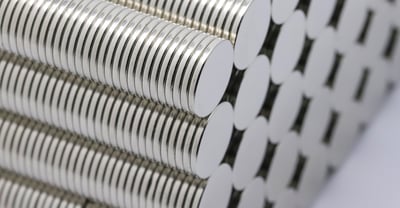Polishing Magnets: A Step-by-Step Guide
Polishing a magnet using a cubic boron nitride wheel requires careful consideration of the wheel selection, polishing technique, and safety precautions. These are the steps we recommend for polishing magnets using diamond or CBN wheels:

Wheel Selection:
Choose a fine-grit diamond or CBN wheel specifically designed for polishing applications. The wheel's grit size typically ranges from around 800 to 3000 mesh, depending on the desired surface finish. Finer grit sizes produce smoother finishes.
Prepare the Magnet:
Clean the magnet thoroughly to remove any dirt, debris, or contaminants that could affect the polishing process. Ensure the magnet is dry before proceeding.
Mount the Wheel:
Mount the selected diamond or CBN wheel onto your grinder or polishing machine according to the manufacturer's instructions. Make sure the wheel is securely attached and properly aligned.
Safety Precautions:
Wear appropriate personal protective equipment (PPE), including safety goggles, gloves, and a dust mask, to protect yourself during the polishing process. Ensure that the polishing area is well-ventilated and coolant is used if possible.
Polishing Technique:
Apply a polishing compound or slurry to the surface of the magnet. The polishing compound may contain a mixture of abrasive particles suspended in a liquid or paste. Start with a small amount and add more as needed during the polishing process.
Begin Polishing:
Gently bring the magnet into contact with the rotating diamond or CBN wheel. Apply light pressure and move the magnet across the wheel's surface in a controlled manner. Keep the magnet moving to avoid concentrating heat in one area. Maintain a consistent speed and pressure throughout the process.
Check Progress:
Periodically check the magnet's surface to assess the progress of the polishing. Adjust the pressure, speed, or application of the polishing compound as needed to achieve the desired surface finish. If necessary, pause the polishing process and clean the magnet to remove excess polishing compound and inspect the surface more accurately.
Multiple Passes:
Depending on the initial surface condition and desired outcome, multiple polishing passes may be necessary. After each pass, clean the magnet and assess the surface finish. Repeat the polishing process with lighter pressure and finer polishing compounds if a higher level of polish is desired.
Final Cleaning:
Once the desired surface finish is achieved, thoroughly clean the magnet to remove any residual polishing compound, coolant or debris. Use an appropriate cleaning solution or solvent recommended for the magnet material. Ensure the magnet is completely dry before proceeding.
Inspection:
Inspect the polished magnet under proper lighting conditions to ensure the desired mirror-like finish has been achieved. Check for any remaining scratches, marks, or imperfections. If necessary, perform additional polishing steps to address any areas that require further refinement.
![]()
Remember to follow safety guidelines, read and adhere to the manufacturer's instructions for the diamond or CBN wheel and polishing compounds, and exercise caution throughout the polishing process. Practice on a sample or scrap magnet before working on a valuable or critical magnet to refine your technique and achieve the desired results.
Subscribe to email updates
Subscribe to our blog to get the latest updates from the experts on Grinding Wheels! You can easily unsubscribe at any time



